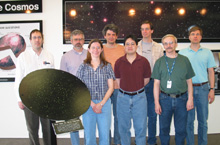 | Thursday, April 7, 2005 |
|
Thursday, April 7 9:30 a.m. Presentations to the Physics Advisory Committee - Curia II THERE WILL BE NO THEORETICAL PHYSICS SEMINAR THIS WEEK 3:30 p.m. DIRECTOR'S COFFEE BREAK - 2nd Flr X-Over 4:00 p.m. Accelerator Physics and Technology Seminar - 1 West Speaker: M. Craddock, TRIUMF Title: FFAGs in 2005
Friday, April 8 |
|
Extended Forecast |
Secon Level 3 |
|
Thursday, April 7 Tomato Florentine Soup Grilled Chicken Cordon Bleu Sandwich $4.75 Chimichangas $3.75 Chicken Marsala $3.75 Maryland Crab Salad $4.75 Italian Sausage Calzones $3.25 SW Chicken Salad with Roasted Corn Salsa $4.75 The Wilson Hall Cafe now accepts Visa, Master Card, Discover and American Express at Cash Register #1.
Wilson Hall Cafe Menu |
| Fermilab Today is online at: http://www.fnal.gov/today/ Send comments and suggestions to today@fnal.gov Fermilab Today archive Fermilab Today PDF Version Fermilab Result of the Week archive Fermilab Safety Tip of the Week archive Linear Collider News archive Fermilab Today classifieds Subscribe/Unsubscribe to |
Robin Staffin Addresses Fermilab Community Today at 11:30 a.m.
|
|
Meet PPD's Mike Crisler (With the Right Job Title) Public Affairs would like to apologize to Mike Crisler, Kurt Krempetz, and the rest of Particle Physics Division for the wrong job descriptions: Krempetz is head of the Mechanical Department in PPD, and Crisler
Crisler is a native of Florence, Alabama. His father's career in the chemical industry took the family to Ohio and later West Virginia. Crisler's first job was cleaning and refurbishing rail cars that transported chlorine gas. His undergraduate studies were at Georgia Tech, and he came to Fermilab in 1979 as a graduate student from Ohio State University working towards his Ph. D. on charm production in a neutrino experiment. Since then, he has been a Wilson Fellow and has collaborated on several experiments including KTeV, the CDMS dark matter search, and most recently on a new dark matter detector called the Chicagoland Observatory for Underground Particle Physics.
Safety is a big concern for Crisler, and he takes personal pride in PPD's
recent achievement of one million staff-hours without a lost-time injury.
"My dad used to come home from work with stories of men hurt on the job,
and I remember how proud he was when his chlorine plant first attained
one million man-hours without a lost time accident," said Crisler. He lives
in Chicago with his wife Ruth. In his spare time, Crisler designs and builds
furniture, and he is trying to regain his southern accent.
His son, Nick, recently enlisted in the Navy.
|
|
Baby Buffalo | |
| |
|
As of yesterday morning, 11 buffalo babies were happily roaming around Fermilab's
pasture. (Click on image for larger version.)
|
|
From the DOE Office of Science, April 4, 2005 The Impact of U.S. Visa Policy on the Department of Energy Office of Science Missions Statement by Dr. Raymond L. Orbach I welcome this opportunity to discuss the impacts of the visa policies on the science missions of the Department of Energy and its National Laboratories. While many of our issues are similar to those expressed by the National Science Foundation, our emphasis is somewhat different, and I appreciate the opportunity to discuss this with you. ...As noted earlier, many foreign researchers have been integrally involved in the research and development, design, construction, and operation of the world class machines at our laboratories, as well as the design and operation of the experiments. Examples:
1) Most of the muon detector of the DZero experiment at the Tevatron at Fermilab was built in Russia. Russian physicists need to be at Fermilab to maintain
and operate the system on behalf of the entire collaboration. There have been
several occasions when planned visits were impacted by visa delays. While
the collaboration managed the issues, there were real concerns that the
researchers would need to turn off the detector during the delays. One of
the key physics searches at the Tevatron, that is, the search for single
top quark production, was delayed for several months because of delays
in the receipt of the visa for a critical hire.
|
|
SDSS Measures Size of the Universe;
Finds Big Bang Echo in Galaxy Distribution |
|
A group of researchers from the SDSS collaboration headed by Daniel
Eisenstein and Fermilab alumna Idit Zehavi, both of U of Arizona, has
detected remnants of cosmic "ripples" from the early universe by
studying the distribution of fairly nearby galaxies. The SDSS
measures the redshifts of galaxies, which can be used to create a
three-dimensional map of the galaxy distribution. Eisenstein, Zehavi
and colleagues analyzed a sample of luminous red galaxies and found
that they tend to cluster on scales of roughly 500 million light
years.
Such a clustering had been predicted by the Big Bang theory: just after the Big Bang, matter in the Universe is distributed smoothly on large scales, but with some graininess on small scales (like the snowy picture on a TV set not tuned to any channel). Small overdensities of matter attract more matter, causing gas to fall in first, then bounce back out, creating so-called acoustic oscillations. The effect of these oscillations had already been seen in the Cosmic Microwave Background by the WMAP satellite. The clustering of galaxies observed by the SDSS comes from the same oscillations, as the small overdensities grow into larger and larger structures by attracting more and more matter. From the scale of the clustering, the scientists determined the ratio between the size of the Universe now and the size of the Universe just after the Big Bang to an accuracy of 4%, and confirmed that the Universe's expansion is accelerated by the presence of the so-called Dark Energy (something invisible with repulsive gravity). For further information see the SDSS press release and the astro-ph preprint. |
|
Result of the Week Archive |
Yesterday's article "Escorts in Fermilab Property Protection Areas" incorrectly
described the two situations in which obtaining an ID badge is not
possible or not practical. The two situations are:
|
|
April 4 - April 6 - During this 48 hour period Operations established two stores that provided the experiments with approximately 33 hours and 2 minutes of luminosity - LRF5 PA tube replaced - Booster chopper "on" tube replaced - TeV quenched during antiproton transfer
Read the Current Accelerator Update |
|
Fermi Singers The Fermi Singers are back! Mark your calendars for April 22 at noon in the Auditorium. The group will present a Spring Concert for your listening pleasure. Snacks will be available for you following the performance!
Travel Information Rack
|




